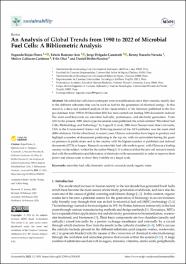An Analysis of Global Trends from 1990 to 2022 of Microbial Fuel Cells: A Bibliometric Analysis

Ver/
Descargar
(application/pdf: 3.569Mb)
(application/pdf: 3.569Mb)
Fecha
2022-02-16Autor(es)
Rojas-Flores, Segundo
Ramirez-Asis, Edwin
Delgado-Caramutti, Jorge
Nazario-Naveda, Renny
Gallozzo-Cardenas, Moisés
Diaz, Félix
Delfin-Narcizo, Daniel
Metadatos
Mostrar el registro completo del ítemResumen
Microbial fuel cells have undergone several modifications since their creation, mainly due to the different substrates that can be used as fuel for the generation of electrical energy. In this research, a deep and updated analysis of the characteristics of the literature published in the Scopus database from 1990 to 30 December 2022 has been carried out, finding 7055 documents indexed. The most used keywords are microbial fuel cells, performance, and electricity generation. From 2011 to the present, 5289 article-type documents were published; the article entitled “Microbial Fuel Cells: Methodology and Technology” by Logan B. E. et al., 2006 from Pennsylvania State University, USA in the Environmental Science and Technology journal of the ACS publisher was the most cited (4496 citations). On the other hand, in recent years, Chinese universities have begun to produce and highlight a number of documents positioning in the top ten, with six universities having the greatest presence in publications and as the country with the highest number of published and indexed documents (2773) in Scopus. Research on microbial fuel cells tends to grow, with China as a leading country on the subject, written by the author Wang X. It is observed that the new cell research trends deal with the modification and fabrication of electrodes with nanomaterials in order to improve their power and reduce costs to show their viability on a larger scale.
Colecciones
- SCOPUS [380]

